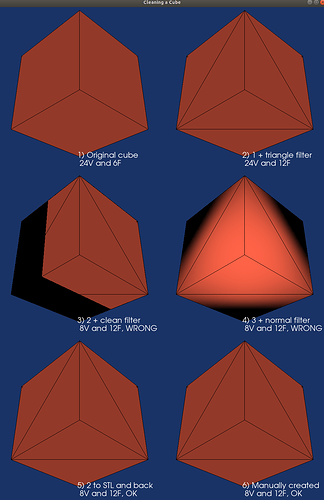Dear all,
I’m a super-casual C++/VTK user and this is my first post here, so excuse my possible naivety, especially in coding (my daily job involves Fortran).
I have troubles in understanding what is the proper way to clean a polydata that has duplicated points (thus, potentially, zero area faces). With polydata I just refer to surfaces made of polygons (no lines, no vertices, no strips). And, to be more specific, I’m actually interested in surfaces made of triangles only.
This is what I have at the moment.
I used a cube source as starting point. Let’s name it as state 1. It has quadrilateral faces (6) and duplicated points (24). In order to reach the desired end result (8 vertices, 12 faces, no duplicate point) I tried different steps.
In the first step I applied a vtkTriangleFilter, because, as I said, I’m interested in triangles only. Of course, I didn’t expect this step to solve the duplicated points issue. Let’s call state 2 the output of this step.
Then, in the second step, I applied the vtkCleanPolyData filter, let’s name the output of this filter as state 3. Unfortunately, state 3 is rendered (not sure if this is the correct term or even if it is the origin of the problem) as if there is some issue with the normals of the faces (see image below).
Self-convinced by the possible issue with the normals, I kind of blindly applied a vtkPolyDataNormals filter, with ConsistencyOn and SplittingOff, let’s name its output as state 4. But the final result was still rendered wrongly (yet, differently from state 3, see the image below).
Then I realized that I could cure those rendering problems in states 3 and 4 by invoking SetInterpolationToFlat from the relative actors. It also made sense, I should not expect Gouraud to do the same as flat in that circumstance.
So far so good. But, then I realized that I could actually achieve what I wanted, with the expected rendering (not sure, at this point, what is the correct way of displaying what I want), in the two following ways (I’m adding states to them for the consistency of the comparison):
a) Writing the polydata to STL and reading it back (state 5)
b) Manually building the polydata (state 6)
All without any call to SetInterpolationToFlat.
I could eventually rely on manually building all my polydata related to simple sources, but I’m left wondering what would be the correct approach to clean a polydata without having the rendering artifacts I am experiencing? Is SetInterpolationToFlat called somewhere in the alternative ways a and b above?
The different states I mentioned above are shown in the picture below:
While the code I used to test this (and from which the picture is taken) is attached here:
CleanPolyData.tar.gz (3.5 KB)
Thanks for any possible help
